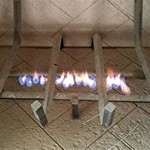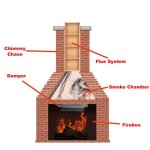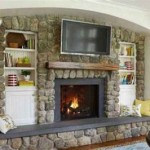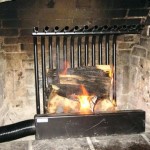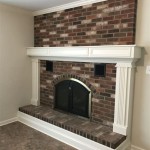How To Hang A Mantel On A Stacked Stone Fireplace
Hanging a mantel on a stacked stone fireplace presents unique challenges compared to installing one on a traditional brick or drywall surface. The irregular surface of stacked stone makes it difficult to achieve a flush and secure mount. However, with the right tools, materials, and techniques, it is possible to install a mantel that enhances the aesthetic appeal of the fireplace and remains safely in place.
This article will detail a comprehensive approach to hanging a mantel on a stacked stone fireplace, focusing on essential considerations, necessary tools, detailed installation steps, and long-term maintenance. It aims to provide readers with the knowledge required to confidently undertake this project, ensuring a professional and lasting result.
Assessing the Stacked Stone Surface and Mantel
Before commencing any installation, a thorough assessment of both the stacked stone surface and the mantel itself is crucial. This initial evaluation will inform the choice of mounting methods and ensure compatibility between the mantel and the fireplace.
The stacked stone surface should be carefully examined for stability. Loose or crumbling stones must be addressed before proceeding. Minor imperfections can be filled with appropriate patching compounds designed for stone. However, significant instability may necessitate professional repair to provide a safe and reliable mounting surface. Consider the depth and variation in the stone's texture. This irregularity will affect the selection of fasteners and the degree of shimming required to achieve a level and stable mantel installation.
Next, consider the mantel. Its weight is a critical factor. Heavier mantels require more robust mounting solutions than lighter ones. The dimensions of the mantel, particularly its depth and width, should also be considered in relation to the size of the fireplace. A mantel that is disproportionately large can overwhelm the fireplace, while one that is too small may appear insignificant. The material of the mantel – wood, stone, or concrete – will influence the choice of fasteners. Wood mantels are generally easier to work with, while stone or concrete mantels may demand specialized anchors.
Finally, consider the desired height of the mantel. Building codes often specify minimum clearances between the top of the fireplace opening and combustible materials. Research local codes and regulations to ensure compliance and prevent fire hazards. Marking the desired height on the stone surface with a level and pencil will provide a visual guide throughout the installation process.
Selecting The Right Tools and Materials
The success of any DIY project hinges on having the right tools and materials. Installing a mantel on stacked stone requires specific items to address the challenges posed by the uneven surface and the weight of the mantel.
Essential tools include a drill with a variety of masonry bits. The size of the drill bit will depend on the type of anchors selected. A hammer drill is highly recommended for drilling into stone, as it provides the necessary impact to penetrate the hard surface. A level, preferably a long one, is crucial for ensuring the mantel is perfectly horizontal. A stud finder can be useful for identifying any underlying framing that may be present and can be used for additional support. Measuring tape is indispensable for accurate measurements and placement. Safety glasses and a dust mask are essential for protecting eyes and lungs from stone dust generated during drilling. A caulking gun is needed if using adhesive caulk for additional support or filling gaps. Shims of various thicknesses are essential for leveling the mantel on the uneven stone surface.
Material selection includes appropriate anchors. Sleeve anchors and wedge anchors are commonly used for mounting on masonry surfaces due to their strength and reliability. The length of the anchor should be sufficient to penetrate deeply into the stone and provide a secure hold. Consider the diameter of the anchor based on the weight of the mantel. Construction adhesive, specifically formulated for stone, can provide additional bonding strength and help to fill gaps between the mantel and the stone surface. Wood screws will be needed if the mantel is secured to a wooden cleat or mounting board. Safety glasses and gloves are necessary to protect from debris and adhesive.
The chosen anchors should be load-rated to handle the mantel's weight, plus a safety margin. Over-engineering the mounting system is always preferable to under-engineering it. Failing to properly support the mantel can lead to its eventual collapse, posing a safety risk and potentially damaging the fireplace surround.
Step-by-Step Installation Process
The installation process requires precision and careful attention to detail. Following a systematic approach will help ensure a successful and secure mantel installation.
The first step is to accurately mark the location of the mounting holes on the stacked stone. Use the level to ensure the marks are horizontally aligned. Transfer the measurements from the mantel to the stone, ensuring that the holes on the mantel align with the marked locations on the stone. This step is critical for a seamless installation.
Next is drilling the pilot holes. Using the appropriate masonry drill bit and hammer drill, carefully drill pilot holes at the marked locations on the stone. Drill straight and deep enough to accommodate the selected anchors. Remove any dust or debris from the holes using a vacuum cleaner or compressed air. This step is critical for proper anchor engagement.
Insert the anchors into the drilled holes. Gently tap the anchors into place with a hammer, ensuring they sit flush with the stone surface. Tighten the anchors according to the manufacturer's instructions. Over-tightening can damage the stone, while under-tightening can compromise the anchor's holding power.
Apply construction adhesive to the back of the mantel, focusing on areas that will come into contact with the stone. This will provide an additional layer of bonding strength. Carefully lift the mantel into position, aligning the mounting holes with the anchors. Secure the mantel to the anchors using appropriate screws or bolts. Tighten the fasteners gradually and evenly to avoid stressing the stone. Use shims as needed to ensure the mantel is perfectly level and flush against the stone surface. Conceal the shims by breaking off the excess material or using color-matched caulk.
Once the mantel is securely mounted, inspect the installation for any gaps or imperfections. Fill any gaps between the mantel and the stone with color-matched caulk. Smooth the caulk with a wet finger or a caulking tool for a clean and professional finish. Allow the caulk to dry completely before applying any weight to the mantel. If the mantel has unfinished sections, apply the appropriate stain or paint to protect the material and enhance its appearance.
Addressing Common Challenges
Installing a mantel on a stacked stone fireplace can present several challenges. Understanding these potential issues and having solutions in place can streamline the installation process.
One common problem is uneven stone surfaces. The natural variations in stacked stone can make it difficult to achieve a perfectly level mantel. Shims are the primary solution for this issue. Use a variety of shim thicknesses to compensate for the unevenness. Carefully check the level at multiple points along the mantel's length to ensure a consistent and accurate result. If large gaps remain, consider using backer rod before applying caulk to prevent excessive caulk use and ensure a more durable seal.
Another challenge is drilling into hard stone. Some types of stacked stone are exceptionally hard, making drilling difficult and time-consuming. Using a high-quality hammer drill with appropriate masonry bits is essential. Apply consistent pressure while drilling, and avoid overheating the drill bit. If the bit becomes dull, replace it immediately. Consider using a diamond core drill bit for extremely hard stones, as these bits are designed for cutting through dense materials.
Weight considerations and mantel support must be seriously considered. Heavy mantels can place significant stress on the anchors and the stone itself. Ensure the anchors are load-rated to handle the mantel's weight with a substantial safety margin. Consider adding additional support by installing a wooden cleat behind the mantel, secured to the wall studs. This will distribute the weight more evenly and reduce the strain on the stone. If possible, attach the mantel to the framing behind the stone using longer bolts or screws instead of relying solely on anchors in the stone. This provides additional stability and support.
If the stacked stone is veneer, meaning it's a thin layer adhered to a wall, not structural, then finding and anchoring to the studs behind the veneer is imperative. The veneer itself cannot support a significant load. Stud finders can help locate the studs, but using a small drill bit to probe for them through the grout lines can confirm their location without causing significant damage.

How To Build And Hang A Mantel On Stone Fireplace Shanty 2 Chic

How To Build And Hang A Mantel On Stone Fireplace Shanty 2 Chic

Fireplace Mantel Installation Before And After

How To Hang Art On A Stacked Stone Fireplace No Grout Lines

Fireplace Mantel Installation Before And After

Fireplace Mantel Installation Casa Di Sassi

How To Build And Hang A Mantel On Stone Fireplace Shanty 2 Chic

How To Install A Stacked Stone Fireplace Practical Whimsy Designs

Eldorado Stone Fireplace Installation With Mantel Time Lapse Installing Veneer

Fireplace Mantel Installation Before And After
Related Posts

